"Life with a Star" - Part 3: Sun Tracking Apparatus

In the continuation of articles on solar activity and space weather, I will talk about automatic devices that allowed us to make significant progress in studying these processes.
Despite the fact that the Sun is perhaps the most important object of the Solar System for us (after the Earth, of course) the number of probes aimed at its study is inferior to that of Venus and Mars. However, taking into account the fact that a significant part of the vehicles sent to Venus and Mars were lost, and the average time of their work did not exceed a couple of years (compared to decades with many vehicles exploring the Sun), the situation in the research apparatus-years is still in favor of The sun
')
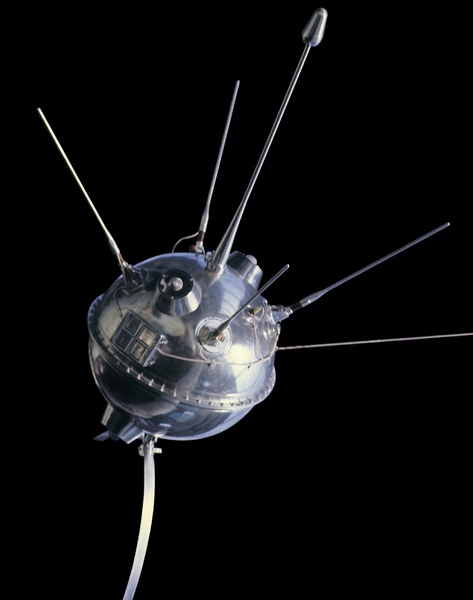
Luna-1 - launched on January 2, 1959. Despite the fact that the main goal (getting into the moon) failed, her mission was very successful. One of the achievements of this device is the first in the history of direct observation of the characteristics of the solar wind .
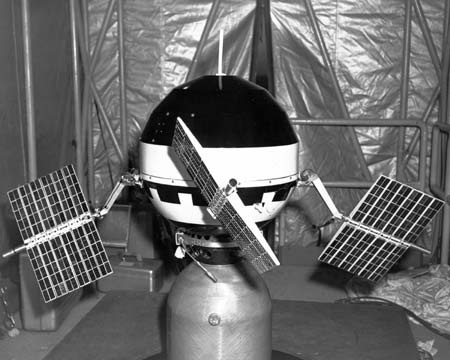
Pioneer-5 - made the first measurements of the interplanetary magnetic field, the level of radiation and the properties of solar flares. Despite the rapid failure (he worked in orbit from March 11 to April 30, 1960), this tiny satellite weighing 45 kg with a diameter of 66 cm is considered the most successful of the entire series of Pioneer satellites.
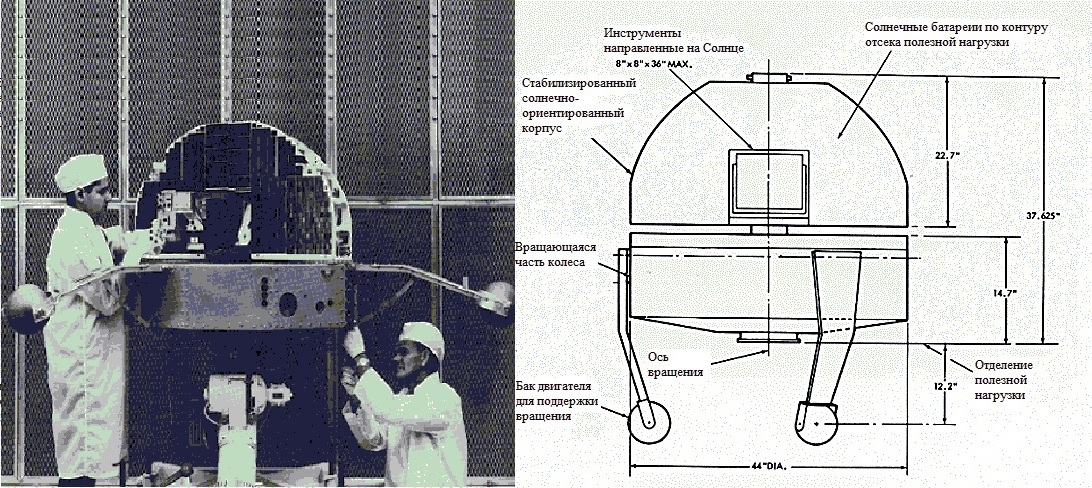
Orbiting Solar Observatory ( Orbiting Solar Observatory ) satellites are 8 consecutively launched vehicles aimed at studying the 11-year solar cycles in ultraviolet and x-rays. From the launch of the first observatory on March 7, 1962 and until the end of the last of them in October 1978, usually two or three vehicles of this series were in orbit. The orientation of the apparatus on the sun was carried out by rotation.
A serious accident is connected with the second device: on April 14, 1964, on tests of integration of the device with the third solid-propellant Delta-C rocket, one of the technicians accidentally set fire to it with a discharge of static electricity, while three people burned in the incident, and the device ricocheted from the roof in the corner of the building . It took 10 months to restore it, after which it was launched on February 3, 1965.
The third unit did have to be made in duplicate, since the modifications in the third stage Delta-C (made after the previous case) led to its premature launch in flight, and the unit itself burned down in dense layers of the atmosphere. Despite this, the new “third” device was able to establish the uniformity of gamma radiation throughout the sky, and also found x-ray flashes from the Scorpius X-1 object. The sixth spacecraft was one of the first to detect gamma-ray bursts , the seventh detected gamma rays in solar flares, and the eighth detected iron lines in clusters of galaxies.
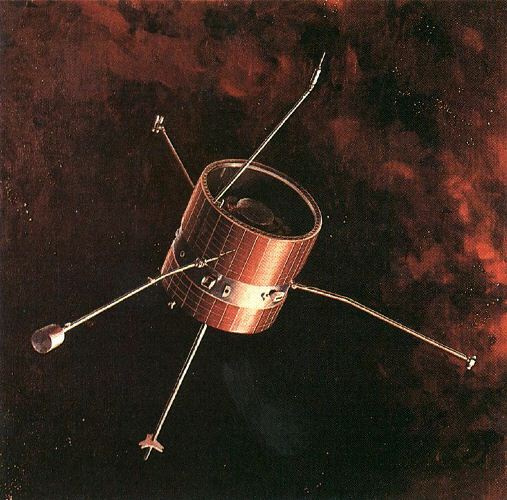
The Pioneer 6-9 series vehicles (their launches were made from December 16, 1965 to November 8, 1968) - these automatic interplanetary stations made long-term measurements of space weather , solar wind and cosmic rays . They can be attributed to the first "long-term" scientific missions - the last connection with the Pioneer-6 device was established on December 8, 2000 (in honor of its 35th anniversary).
Presumably, with the exception of Pioneer 9, which failed in 1983, they are still functional. The main reason for not using them further is the archaic nature of the instruments (the capabilities of which overlapped the new satellites) and communication facilities (requiring huge plates at a communication speed of 512 bit / s).
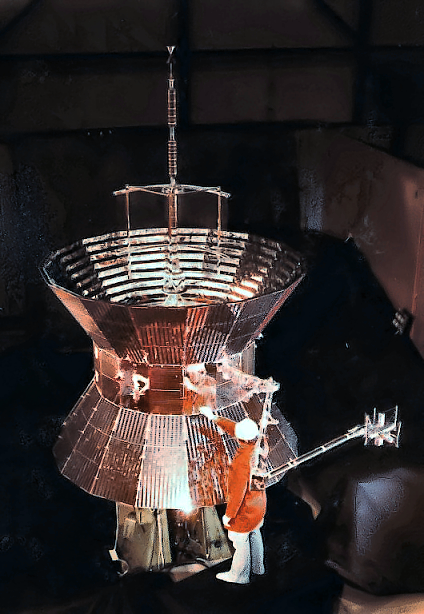
A pair of devices of the Helios series (launched on December 10, 1974 and January 15, 1976) is a joint development of NASA and DFVLR (then also in the Federal Republic of Germany ). They studied the interplanetary environment including studies of cosmic dust , cosmic rays, interplanetary magnetic field. With the help of them, helium ions were also detected for the first time in the solar wind.
For a more detailed study of the Sun, they were sent to a heliocentric orbit with a perihelion of 0.3 astronomical units (no one came up so close to the Sun from AMC ). The devices were able to detect "magnetic clouds" from the plasma (together with another satellite, SMM ), but at the time they could not link their origin with coronal mass ejections.
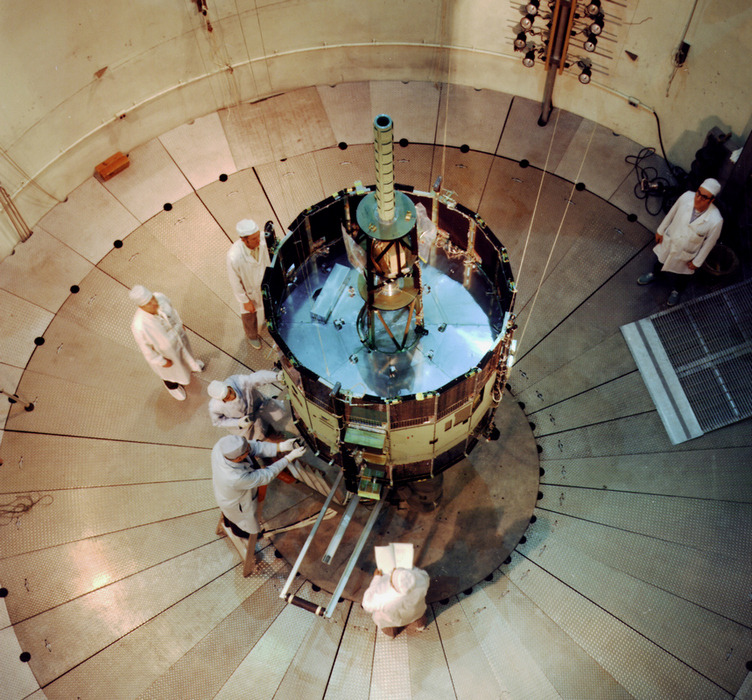
The international comet explorer - launched on August 12, 1978, became the first spacecraft launched into orbit by Lissajous , at which it rotates around the L 1 point between the Earth and the Sun. The device has three detectors of cosmic rays of various energies, detectors of protons and magnetic fields, waves in a plasma, and x-rays. Having completed his main mission on the study of solar-terrestrial connections, solar wind and cosmic rays on June 10, 1982, he was sent to study comet Jacobini-Zinner , whose tail he passed on September 11, 1985.
On May 5, 1997, the device was sent by NASA to "retire" with the shutdown of all scientific instruments. In 1999 and 2008, NASA verified its condition. In April 2014, a project to restore communication with this device, which collected almost $ 160 thousand, appeared on the RocketHub crowdfunding platform. Already on May 29, 2014, this team managed to establish a connection with the device (with the permission of NASA, of course). And on July 2, they tried to start its engines for the first time since 1987, but this was not possible due to the lack of nitrogen to pressurize the tanks. The team continued to work with scientific instruments until September 16, when contact with the device was lost. Presumably this was due to the reduction in the release of energy by solar panels, as the device flew past the Earth flying away from the Sun at that moment (so communication with the device was already lost in 1981). The next meeting of the apparatus with the Earth should occur in 2031.

Voyager 1 and 2 - although the main purpose of these vehicles was to study the outer planets of the solar system, they also contributed to the study of the sun: they were used to refine the properties of the solar wind at different distances from the sun, the speed of propagation of coronal emissions of matter and location the head shock wave of the solar system (places where the solar wind collides with the interstellar medium).
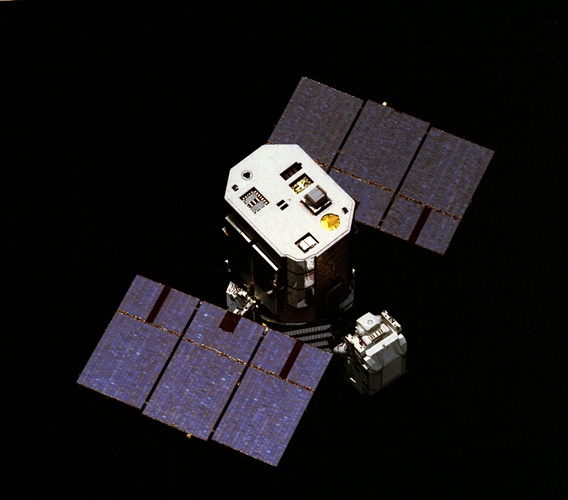
Solar Maximum Mission (also known as SolarMax or simply SMM) was launched on February 14, 1980 to study solar phenomena. Already by June 21, he managed to detect neutrons produced during a solar flare (this is a rather rare event and is recorded on average once a year) and also fails quickly - in November. The device lost its orientation on the Sun and spent in this state until April 1984, when the mission of the Space Shuttle STS-41-C did not fix it.
It wasn’t immediately possible to catch the satellite for repair: in the beginning they tried to do it with the help of a manned maneuvering module ( MMU , unfortunately after the Challenger disaster, they refused to use it at all), then they tried to use the Canadarm manipulator. As a result, it was possible to dock only the next day after issuing signals to the device from the ground and reducing the frequency of its rotation.
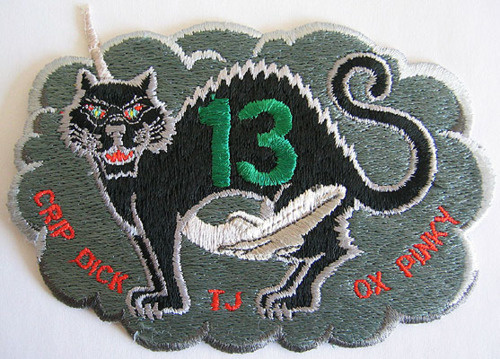
The entire mission of the Space Shuttle was ultimately successful, and the satellite orientation system with one of the scientific instruments was repaired, as well as the photo presented above. Despite such an alternative mission emblem (denoting the landing date, produced on Friday the 13th), the SMM worked before entering the atmosphere on December 2, 1989, simultaneously opening several near-solar comets.
Also, the device was able to establish that during the solar maximum (when the number of sunspots increases dramatically) the luminosity of the sun does not fall, but rather increases - this is due to the presence of solar flares around the sunspot which, on the contrary, have an increased luminosity.

AMC "Ulysses" - launched on October 6, 1990, a joint project of ESA and NASA. It was the first apparatus launched at a large angle to the ecliptic plane of the solar system. His task was to study the poles of the Sun and a little Jupiter (during the gravitational maneuver to reach the required orbit and pass by in 2004). The device was able to establish that the south pole of the sun does not have a fixed position (as well as the north one), and after passing through the tails of several comets he managed to establish that their length can extend several astronomical units in length.
But everything has its price, as well as Ulysses being displayed as the main load of the Space Shuttle "Discovery" (having a load capacity of 24.4 tons per DOE) and accelerated by two additional steps, had a total weight of only 365 kg of which only 55 kg was accounted for by scientific equipment . In this regard, the device had a very limited set of instruments: detectors of ions and electrons, cosmic dust and rays. This list did not include any cameras, so we still do not have any photographs of the poles of the sun.
Since the AMC "Ulysses" during the launch into orbit had to move away right up to Jupiter, then an RTG was used as a power source, and since the mass of the device was severely limited, its power was very small. So the reduction of the power of the RTGs led to the fact that even the 70-meter long plates of the NASA long-distance communication network began to lose its signal at the end of the life of the device, and in 2008 the reduction of its power caused the fuel (hydrazine) to freeze, the device could not maneuver and was lost ( although having worked by that time for 17 years and 4 times exceeding the estimated useful life).
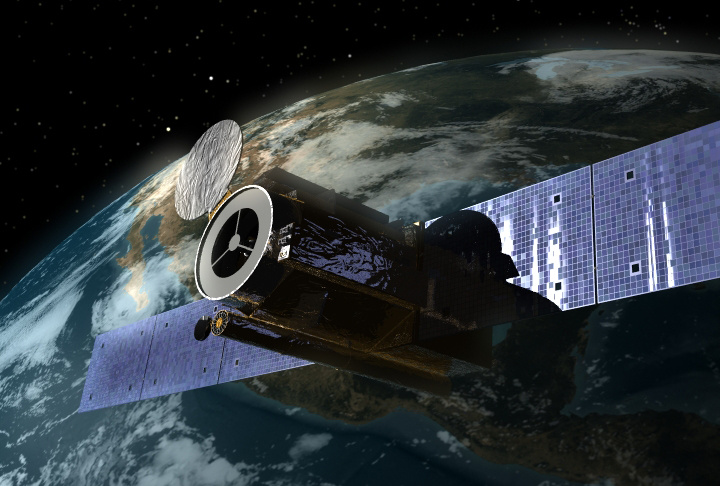
Solar-A and Solar-B are devices that, after launch, received the more harmonious names “Yohkoh” (Sunbeam) and “Hinode” (Sunrise). This is a joint project of Japan, the UK and the USA. The devices for this project were launched on August 30, 1991 (worked until December 14, 2001) and on September 23, 2006 (still in operation).
“Sunbeam” for the first time had a CCD array among space X-ray telescopes, and also had another X-ray telescope of a more rigid spectrum and a pair of spectrometers for searching for ions of iron, sulfur and calcium. "Sunrise" received a 0.5 meter optical and X-ray telescope, as well as an ultraviolet spectrometer.
The main purpose of the work of both vehicles was to study the magnetic field of the Sun through its various manifestations. The second unit succeeded in detecting Alfven waves on the Sun, and also found direct evidence that magnetic reconnection is the source of solar flares.
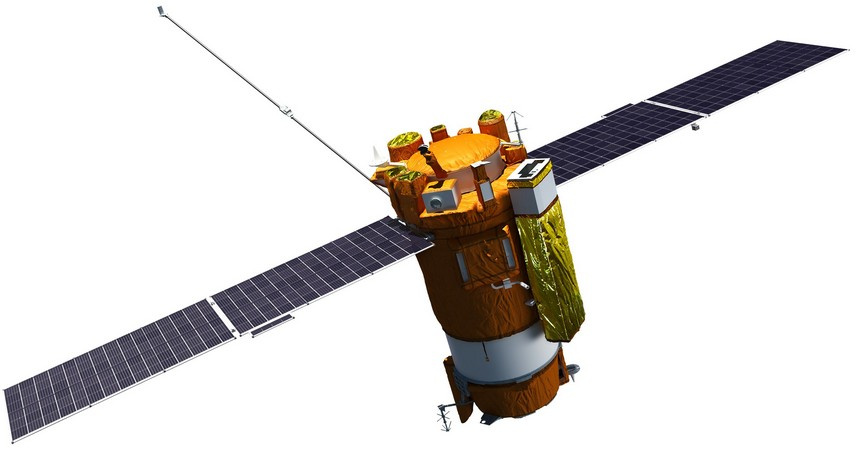
The Coronas series of vehicles is a joint project of Roscosmos and the Russian Academy of Sciences (and earlier also of Ukraine), which provided for the study of the Sun during one 11-year cycle. The research program was to be implemented through the sequential launch of 3 vehicles: the Coronas-I, the Coronas-F and the Coronas-Photon. The vehicles had a wide range of tasks: the study of various manifestations of solar weather, seismological studies of the internal structure of the Sun, the study of the interaction of active phenomena on the Sun with emissions of charged particles and their interaction already with the upper layers of the atmosphere.
To do this, the devices were installed receivers almost the entire spectrum of electromagnetic radiation: from radio to gamma. Russia, Ukraine, India and Poland participated in the creation of instruments for it. Funding problems forced the launch dates to be shifted, but the reliable operation of the first two devices made it possible to virtually offset the consequences of this: Koronas-I launched on March 2, 1994, worked until March 2001, and Koronas-F launched on July 31, 2001 from orbit in December 2005 ( the lesser service life of the second vehicle was caused by the influence of the solar maximum on the Earth’s atmosphere and, consequently, by a more rapid deceleration of the vehicle in a low orbit (which in the case of both vehicles was about 550 km).
However, the third device ( Koronas-Foton ) launched on January 30, 2009 was less fortunate: it was able to work only 278 days after which it failed due to failures in the Meteor platform (although all scientific instruments continued to operate). During the Coronas-Photon work, 380 GB of scientific information was collected.

WIND was designed to study the solar wind. Although it was launched on November 1, 1994, before the next device on this list, but due to the desire of scientists to study the magnetic field of the Earth and the environment surrounding the Moon on Wednesday, he joined him at the Lagrange point L 1 only 10 years later. WIND is 2.4 m in diameter with a height of 1.8 m and a dry weight of 895 kg, while the stabilization of the apparatus by rotation allowed it to install on it 2 “short” magnetometers 12 and 15 m long, and one long 100-meter magnetometer adjustable length of wire. The apparatus also contains detectors of ions and electrons of two energy ranges and two gamma spectrometers, one of which was turned off due to depletion of reserves, and the other (produced by the Institute of Physics and Technology ) continues to work, like the device itself until now. During this time, WIND has become a source for 4300 scientific publications. The residues from 300 kg of fuel to the apparatus should suffice for another 50 years of being at the point L 1 .
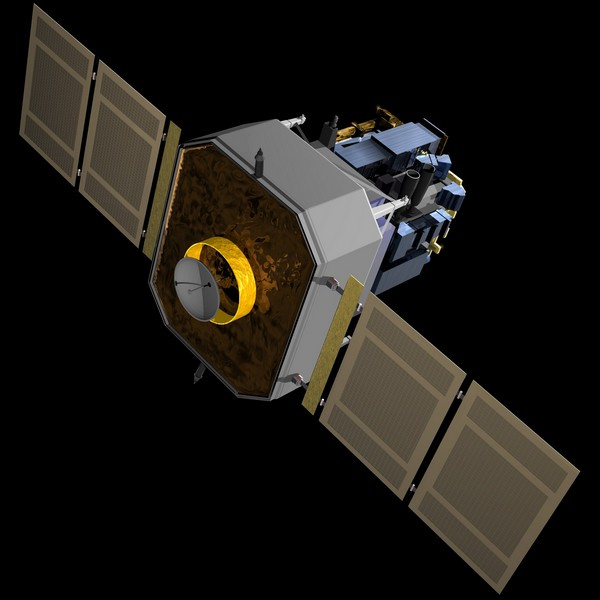
SOHO is a joint NASA and ESA project launched as early as December 2, 1995, which continues to work until now. On board there are as many as 12 instruments, some of which remain unique to this day (although another part has already been disabled due to the launch of a newer SDO into orbit):
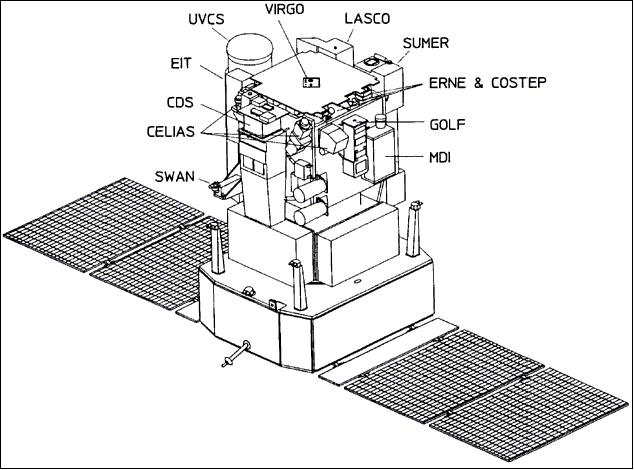
SOHO Instrument Description
CDS (Coronal Diagnostics Spectrometer - spectrometer for coronal diagnostics);
CELIAS (Charge, Element, and Isotope Analysis System - a system for analyzing charges, elements, and isotopes);
COSTEP (Comprehensive Suprathermal and Energetic Particle Analyzer - analyzer of hot and vigorous particles);
EIT (Extreme ultraviolet Imaging Telescope - ultraviolet telescope);
ERNE (Energetic and Relativistic Nuclei and Electron experiment - experimental observation of relativistic nuclei and electrons);
GOLF (Global Oscillations at Low Frequencies - to observe the low-frequency global oscillations of the Sun);
LASCO (Large Angle and Spectrometric Coronagraph - a wide-angle spectrometric coronagraph). Three of these coronagraphs study coronal mass ejections. Also, with the help of these coronagraphs, many near-solar comets have been discovered;
MDI \ SOI (Michelson Doppler Imager \ Solar Oscillations Investigation - Doppler shift meter). This tool receives maps of the solar magnetic field and substance velocities at the height of the line of observation;
SUMER (Solar Ultraviolet Measurements of Emitted Radiation - a tool for measuring flux of ultraviolet radiation);
SWAN (Solar Wind Anisotropies - solar wind anisotropy meter);
UVCS (Ultraviolet Coronagraph Spectrometer - ultraviolet spectrometer);
VIRGO (Variability of Solar Irradiance and Gravity Oscillations - a tool for the study of solar constant and gravitational oscillations)
CELIAS (Charge, Element, and Isotope Analysis System - a system for analyzing charges, elements, and isotopes);
COSTEP (Comprehensive Suprathermal and Energetic Particle Analyzer - analyzer of hot and vigorous particles);
EIT (Extreme ultraviolet Imaging Telescope - ultraviolet telescope);
ERNE (Energetic and Relativistic Nuclei and Electron experiment - experimental observation of relativistic nuclei and electrons);
GOLF (Global Oscillations at Low Frequencies - to observe the low-frequency global oscillations of the Sun);
LASCO (Large Angle and Spectrometric Coronagraph - a wide-angle spectrometric coronagraph). Three of these coronagraphs study coronal mass ejections. Also, with the help of these coronagraphs, many near-solar comets have been discovered;
MDI \ SOI (Michelson Doppler Imager \ Solar Oscillations Investigation - Doppler shift meter). This tool receives maps of the solar magnetic field and substance velocities at the height of the line of observation;
SUMER (Solar Ultraviolet Measurements of Emitted Radiation - a tool for measuring flux of ultraviolet radiation);
SWAN (Solar Wind Anisotropies - solar wind anisotropy meter);
UVCS (Ultraviolet Coronagraph Spectrometer - ultraviolet spectrometer);
VIRGO (Variability of Solar Irradiance and Gravity Oscillations - a tool for the study of solar constant and gravitational oscillations)
SOHO has a very unique and interesting history : initially, the mission of the device was calculated for two years, but having started work in May 1996 already on June 24, 1998, communication with the device was lost during planned calibrations of gyroscopes (the device lost its orientation to the Sun, which could not restore).
Since the device was very valuable and did not want to lose it at all, the ESA specialists immediately went to the USA in order to be able to use the help of NASA, apart from their plates, in addition to their plates. However, a whole month of daily attempts at communicating with the apparatus did not yield results, and the experts went almost to an unprecedented step: using the 305-meter radio telescope at Arecibo at the same time to transmit and the 70-meter Goldstone telescope to receive, for more than an hour they tried to establish the current position of SOHO. In the course of this, the device was found near the expected position, but the data showed that it rotates at a speed of 1 turn in 53 seconds with the solar panels lost their orientation on the Sun.
Only by August 3, when the orientation of the solar batteries was partially restored and the batteries of the device began to charge, a short signal was received from him in a few seconds long. After charging both batteries on August 12, SOHO was given the command to turn on the heaters of the tanks with hydrazine, which by that time was completely frozen. Several times the warm-up process had to be suspended as the telemetry showed that the batteries started to discharge (the orientation of the solar cells was not accurate and they did not cover the heaters' energy needs, and the “rescue team” SOHO did not want to risk reducing the battery charge). After the process of heating the fuel tanks and fuel pipelines, SOHO was again oriented to the Sun on September 16. Then the gradual recovery of the instruments started: SUMER - was launched the first on October 7, COSTEP and ERNE were switched on on the 9th, UVCS - on the 10th, MDI - on the 12th, LASCO and EIT - the 13th, CDS and SWAN - 17- first, and only on October 23, with the launch of the last device (CELIAS), the device fully restored its functionality.
However, this was not the end of his adventures: after the restoration of the working capacity of scientific instruments, it turned out that only 1 of the 3 gyroscopes of the device continues to work, and on December 21 the remaining gyroscope was also out of order. The ESA had to develop a new work program for SOHO so that it could continue to work without spending the remaining precious fuel. The apparatus was reprogrammed on February 1, 1999.
Despite this start, a terrible start, the device continues to work without significant failures.But any equipment eventually becomes obsolete, and with the SDO placed into orbit at the beginning of 2010, some SOHO devices having common tasks began to be turned off: in July 2010, the EIT device was transferred to a limited mode and takes only two sets of images per day (for the sake of maintaining a continuous series of observations), since April 12, 2011, the MDI device has been turned off, on 23rd of January 2013 - UVCS, on August 8, 2014 - SUMER, and on September 5th - CDS.
In addition to its main mission, SOHO, with the help of volunteers, helped to open 2,000 comets by December 26, 2010, and by September 13, 2015, their number exceeded 3,000 - thus, using the SDO, more than half of all the known comets were discovered .
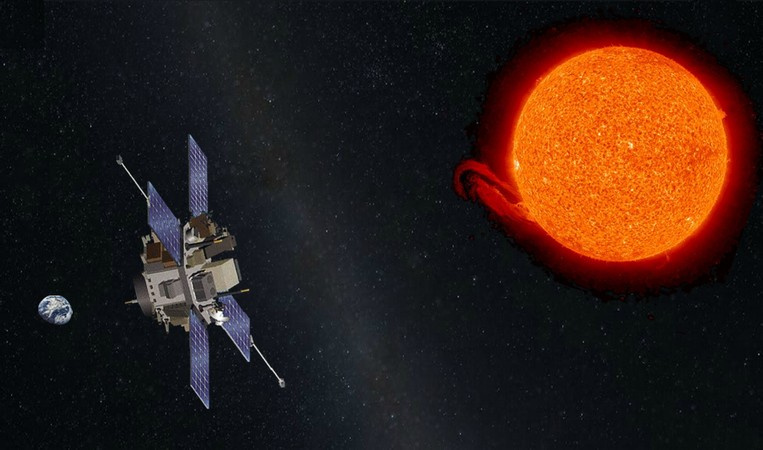
Advanced Composition Explorer- This device was launched on August 25, 1997 to study high-energy particles of the solar wind and interplanetary medium. At present, ACE serves mainly to refine predictions of magnetic storms half an hour before their arrival, due to its position at Lagrange point L 1 1.5 million km from the Earth on the Earth-Sun line. The location of this point also allows him to significantly save fuel: August 15 will be executed 20 years from the moment of its launch, and it has about 37 kg of fuel residues, which should be enough for him even before 2026 .
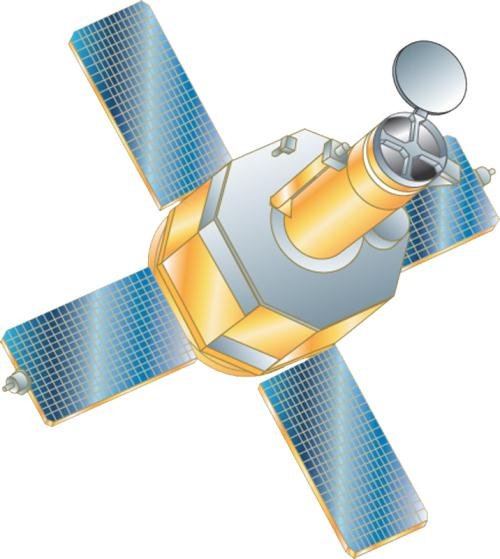
TRACE is a small 30 cm aperture telescope launched on April 2, 1998 as part of the Small Research Program (SMEX) projectNASA provides for projects cheaper than $ 120 million. The device carried out surveying of the solar regions of 8.5 angular minutes (approximately 14 of its total area) using a CCD array with a resolution of 1000x1000 pixels in the range from visible to far ultraviolet. From April 20, 1998 until 2010, he searched for links between magnetic fields and a plasma structure in the solar atmosphere (photosphere, chromosphere and corona).

“High Energy Solar Spectrograph named after Reuven Ramati ” or RHESI- X-ray and gamma spectrum observatory aimed at studying solar flares, which was launched on February 5, 2002 under the SMEX program. She was the first to succeed in capturing gamma radiation from a flash and determine that the frequency of such gamma bursts is more often than previously assumed. RHESI continues to work so far, and with the help of its data 774 scientific articles have already been written .
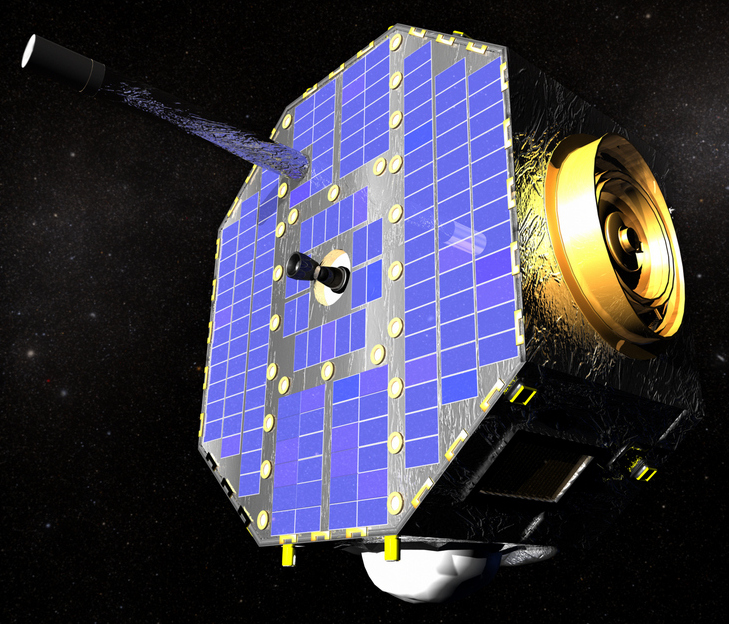
“Interstellar Investigator” or IBEX is a tiny satellite weighing only 80 kg and launched from an airplane on a Pegasus rocketOctober 19, 2008 as part of the SMEX program. It has two high and low energy neutral particle detectors that are designed to measure the limits of the solar heliosphere. At the end of its main 2-year mission, the satellite was able to clarify the speed of our solar system relative to the interstellar medium (the measurement speed was 23.2 km / s relative to 26.3 km / s measured earlier by AMC Ulysses). And at the end of its extended mission, IBEX discovered a plasma tail near the solar system. The satellite continues to work so far, the speed of communication with it is only 16 kbit / s.
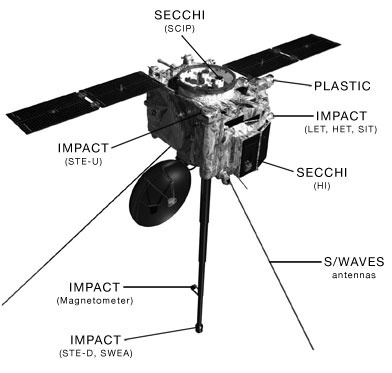
A pair of devices STEREO-A and Blaunched in 2006, they have 4 sets of instruments: SECCHI - for the study of the corona and heliosphere (one camera of the far ultraviolet spectrum and two pairs of coronagraphs and cameras for shooting the solar wind); IMPACT — Coronary Particle Detectors; PLASTIC - detectors of protons, alpha particles and heavy ions; SWAVES - antenna for measuring disturbances in the radio range in the direction of the Sun-Earth.
The main task of these devices is to build 3D models of coronal mass ejections, which was very important for building a model of their formation (the fact is that solar flares and coronary emissions are always taken by different cameras, which is why it was very difficult to link them in 2D images between themselves). To accomplish their mission, they were sent into orbits around the Sun in such a way that one unit would overtake the Earth a little, and the other would lag behind it a little. Thus, they received a picture of two points equally spaced from the Earth, which gradually moved away. From mid-2011, their distance from the Earth allowed to get a complete picture of the Sun (until the STEREO-B apparatus lost its orientation on October 1, 2014):
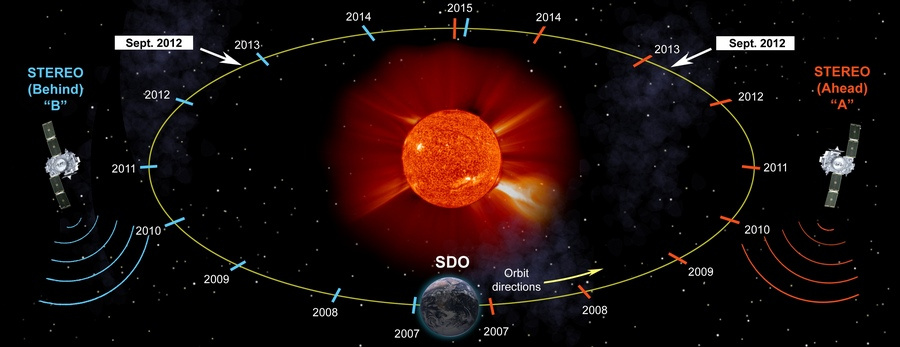
Since the vehicles had to move far from the Earth in the process (up to 2au ) for communication, they use directional antennas, which must be precisely directed to Earth. Problems with STEREO-B occurred during planned tests that simulate the loss of communication devices in the process of passing them behind the Sun (the same problems experienced by rovers and satellites in Mars orbit that lose contact with the Earth for a couple of weeks when Mars sets behind the Sun).
Communication with the device was temporarily restored on August 21, 2016, but due to too fast rotation, it was not possible to restore its orientation to Earth since the flywheels did not have enough torque to completely stop the rotation, and there was no time to defrost the fuel tanks until the new communication loss . Unfortunately, the next opportunity to establish a connection with it will appear only in 2022 (when its antenna will again be directed to the Earth). The mission team took into account the error and STEREO-A without any problems survived the passage of connection with the Sun for several months in 2015 and continues to work so far in normal mode. PROBA2 - the second of a series of low-cost missions of the ESA 130-kg satellite that was launched on a rocket "Rokot"
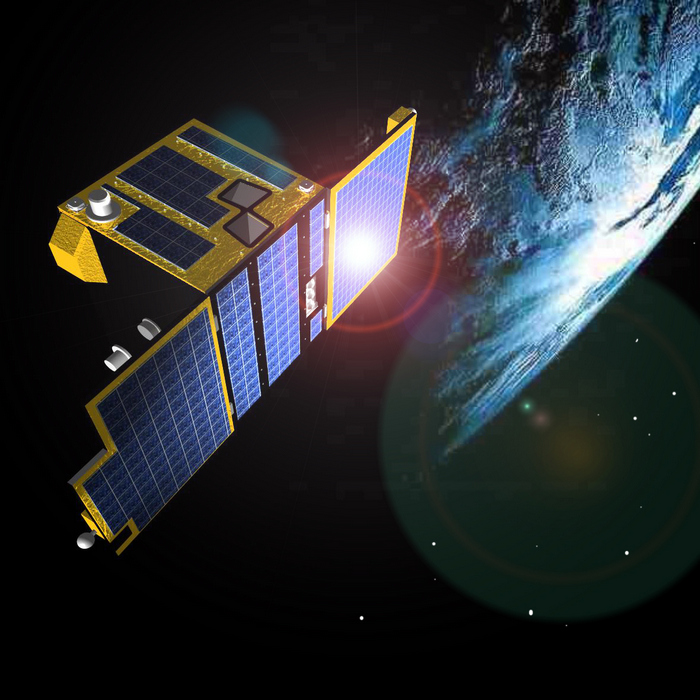
November 2, 2009. The device is a demonstrator of new technologies, carrying on itself also 4 scientific experiments: radiometer spectra of Lyman- alpha, aluminum and zirconium, a telescope of the far-ultraviolet range with a CMOS matrix for studying the Sun; a DSLP detector for measuring the density and temperature of electrons; and a TPMU detector for measuring the density and composition of ions in the Earth’s magnetospheric plasma. Initially calculated as a 2-year mission, according to current plans it has been extended until the end of 2018. The Solar Dynamics Observatory ( SDO ) was launched into orbit on February 11, 2010 using an Atlas-5 rocket with an RD-180 engine .
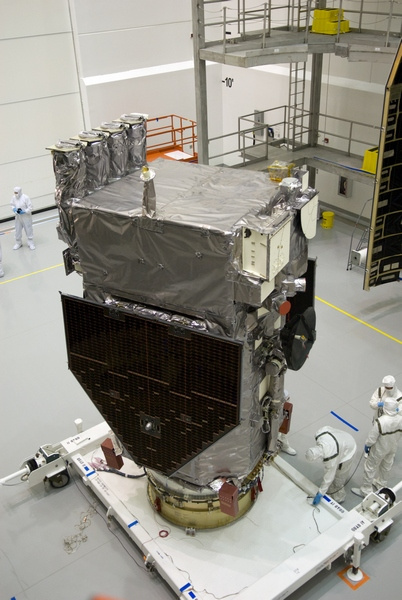
after which she took her position in geosynchronous orbit. This observatory has on its board a magnetometer and 11 cameras of different ranges that shoot the entire surface of the Sun with an interval of 12 seconds and a resolution of 4096x4096 pixels, which gives a data flow of about 1.5 terabytes of data per day. Photographs of the Sun made by the observatory in 11 different regions of the spectrum with an interval of less than a minute. Such a large data stream required special efforts to maintain it: the device has two extremely directional antennas for data transmission and one separate one for telemetry. Ground equipment consists of two 18-meter antennas designed exclusively for communication with SDO. This system allows you to have a total channel of 130 Mbit / s with two antennas working at once. The device has its own website
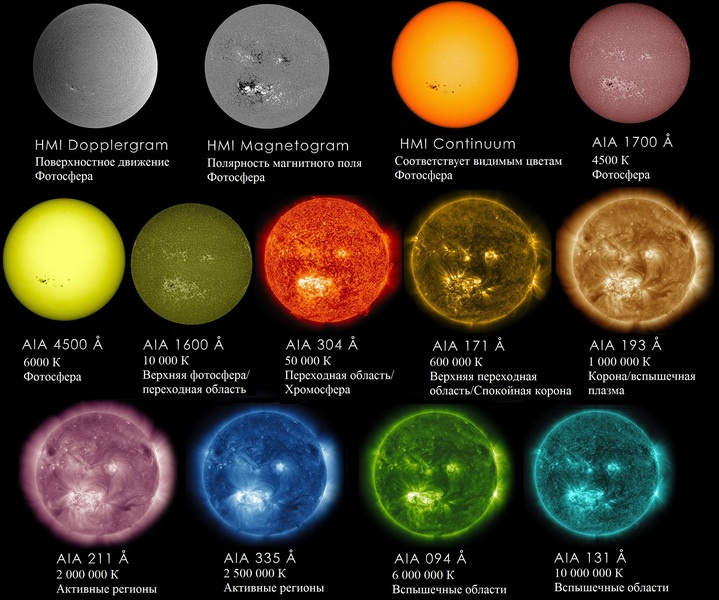
where you can see pictures of the sun in real time. And every year, approximately on the “birthday” of the SDO, the Goddart Space Flight Center lays out a video made up of photographs taken during this time: 1 year , 2 years , 3 years , 4 years , 5 years , 6 years , 7 years . DSCOVR launched on February 11, 2015, by June 8, it was already the 7th vehicle that reached the L 1 point of the Earth-Sun system. The structure of this observatory includes a PlasMag instrument set consisting of a magnetometer (pictured in the folded state), a Faraday cup
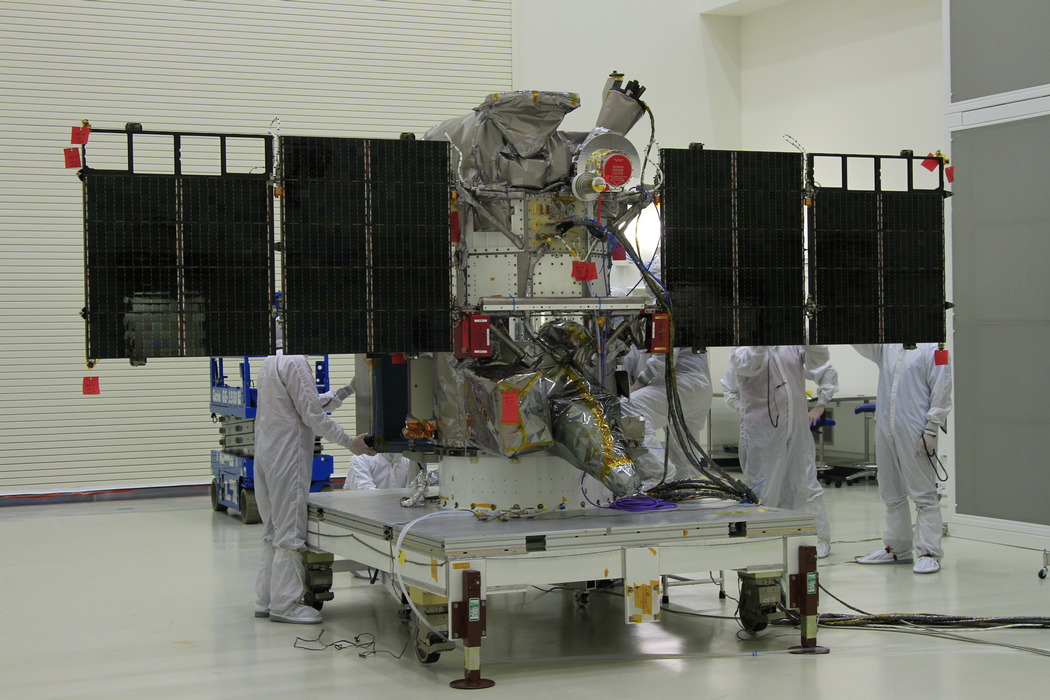
for registration of positively charged particles and an electrostatic analyzer for registration of electrons. The device also includes a NISTAR device for measuring the entire spectrum of sunlight reaching the Earth in 4 ranges (to increase the accuracy of our knowledge about the influence of the Sun on climate change on the Earth) and an EPIC color camera that captures the Earth in 10 color channels of visible light with a resolution of 2048 × 2048 pixels , with the help of which a lot of beautiful gif-ok is made by the rotation of the Earth and the passage of the Moon in front of it (9 MB photo).
A list of current and planned NASA missions to study solar-terrestrial relationships.
Source: https://habr.com/ru/post/373887/
All Articles